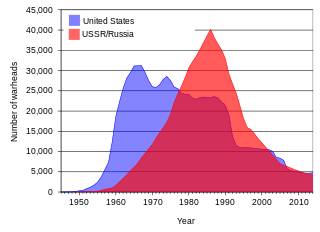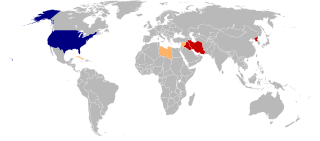
An anti-ballistic missile (ABM) is a surface-to-air missile designed to counter ballistic missiles. Ballistic missiles are used to deliver nuclear, chemical, biological, or conventional warheads in a ballistic flight trajectory. The term "anti-ballistic missile" is a generic term conveying a system designed to intercept and destroy any type of ballistic threat, however it is commonly used for systems specifically designed to counter intercontinental ballistic missiles (ICBMs).

The Strategic Defense Initiative (SDI) was a proposed missile defense system intended to protect the United States from attack by ballistic strategic nuclear weapons. The concept was first announced publicly by President Ronald Reagan on 23 March 1983. Reagan was a vocal critic of the doctrine of mutual assured destruction (MAD), which he described as a "suicide pact", and he called upon the scientists and engineers of the United States to develop a system that would render nuclear weapons obsolete.

Paul Dundes Wolfowitz is an American political scientist and diplomat who served as the 10th President of the World Bank, United States Ambassador to Indonesia, U.S. Deputy Secretary of Defense, and former dean of the Paul H. Nitze School of Advanced International Studies at Johns Hopkins University. He is currently a visiting scholar at the American Enterprise Institute, working on issues of international economic development, Africa and public-private partnerships, and chairman of the U.S.-Taiwan Business Council.
The Hwasong-7, also known as Rodong-1 or Nodong-1, is a single-stage, mobile liquid propellant medium-range ballistic missile developed by North Korea. Developed in the mid-1980s, it is a scaled up adaptation of the Soviet SS-1, more commonly known by its NATO reporting name "Scud". Inventory is estimated to be around 200–300 missiles. US Air Force National Air and Space Intelligence Center estimates that as of June 2017 fewer than 100 launchers were operationally deployed.

Stephen A. Cambone was the first United States Under Secretary of Defense for Intelligence, a post created in March 2003. Cambone first came to the attention of the public at large during the testimony of Major General Antonio Taguba before the U.S. Senate Armed Services Committee, where he disputed the General's statement that prison guards were under the effective control of military intelligence personnel and interrogators. Cambone resigned at the beginning of 2007 and was replaced by James R. Clapper, Jr., former head of the Defense Intelligence Agency (DIA) and the National Geospatial-Intelligence Agency. Cambone was associated with the Project for the New American Century, participating in the study which resulted in the writing of the report Rebuilding America's Defenses.

The Senate Report on Iraqi WMD Intelligence was the report by the United States Senate Select Committee on Intelligence concerning the U.S. intelligence community's assessments of Iraq during the time leading up to the 2003 invasion of Iraq. The report, which was released on July 9, 2004, identified numerous failures in the intelligence-gathering and -analysis process. The report found that these failures led to the creation of inaccurate materials that misled both government policy makers and the American public.

Missile defense is a system, weapon, or technology involved in the detection, tracking, interception, and destruction of attacking missiles. Originally conceived as a defence against nuclear-armed intercontinental ballistic missiles (ICBMs), its application has broadened to include shorter-ranged non-nuclear tactical and theater missiles.

Ashton Baldwin Carter is an American public policy professor who served in several positions within the United States Department of Defense, including as the 25th Secretary of Defense from February 2015 to January 2017.
William J. Schneider Jr. is an American who has served in a number of prominent federal government positions.
Taepodong-1 was a three-stage technology demonstrator developed by North Korea, a development step toward an intermediate-range ballistic missile. The missile was derived originally from the Scud rocket and was tested once in 1998 as a space launch vehicle. As a space launch vehicle, it was sometimes called the Paektusan 1.

Team B was a competitive analysis exercise commissioned by the Central Intelligence Agency (CIA) to analyze threats the Soviet Union posed to the security of the United States. It was created, in part, due to a 1974 publication by Albert Wohlstetter, who accused the CIA of chronically underestimating Soviet military capability. Years of National Intelligence Estimates (NIE) that were later demonstrated to be very wrong were another motivating factor.

William Robert Graham is an American physicist who was Chairman of President Reagan's General Advisory Committee on Arms Control from 1982 to 1985, a Deputy Administrator and Acting Administrator of NASA during 1985 and 1986, and Director of the White House Office of Science and Technology Policy and concurrently Science Adviser to President Reagan from 1986 to 1989. He then served as an executive in national security-related companies.
Theodore A. Postol is a professor emeritus of Science, Technology, and International Security at the Massachusetts Institute of Technology and is a critic of U.S. government statements about missile defense. He has also criticized the US government's analysis of the 2013 Ghouta chemical attack in Syria. He has argued that the Ghouta chemical attack does not seem to have been launched by the Syrian government. He has also criticized the analysis by the US and other western governments of the April 4, 2017, Khan Shaykhun chemical attack in Syria.
This article deals with activities of the U.S. Central Intelligence Agency, specifically dealing with arms control, weapons of mass destruction (WMD) and weapons proliferation. It attempts to look at the process of tasking and analyzing, rather than the problem itself, other than whether the CIA's efforts match its legal mandate or assists in treaty compliance. In some cases, the details of a country's programs are introduced because they present a problem in analysis. For example, if Country X's policymakers truly believe in certain history that may not actually be factual, an analyst trying to understand Country X's policymakers needs to be able to understand their approach to an issue.

The Strategic Rocket Forces, also known as Missile Guidance Bureau is a military branch of the Korean People's Army that oversees North Korea's nuclear and conventional strategic missiles. It is mainly armed with surface-to-surface missiles of domestic design as well as older Soviet and Chinese models.

Scud is the name of a series of tactical ballistic missiles developed by the Soviet Union during the Cold War. It was exported widely to both Second and Third World countries. The term comes from the NATO reporting name attached to the missile by Western intelligence agencies. The Russian names for the missile are the R-11, and the R-17Elbrus. The name Scud has been widely used to refer to these missiles and the wide variety of derivative variants developed in other countries based on the Soviet design.
Missile defense systems are a type of missile defense intended to shield a country against incoming missiles, such as intercontinental ballistic missile (ICBMs) or other ballistic missiles. The United States, Russia, India, France, Israel and China have all developed missile defense systems.

The Dong-Feng 26 is an intermediate-range ballistic missile deployed by the People's Liberation Army Rocket Force produced by the China Aerospace Science and Technology Corporation (CASC).






















